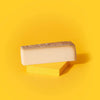The Ultimate Guide to Gruyere Cheese
By Claragh Nugent
Apr 1, 2022

Gruyere (pronounced groo-YEAH) cheese is absolute perfection. Yep, that’s right. It’s a cheese that can do no wrong in our eyes. With a sweet yet nutty flavour, and an amazing funky tang, it's got more complexity than an Agatha Christie novel, but maintains that super moreish and a texture smoother than silk (complimented by that dreamy crunch for more aged versions). It’s easy to melt, and you’ll be able to whip up the grilled cheese sandwich of dreams in no time.
Wonder where Gruyere gets all that unique flavour? Well amongst many things, it is the cloth used to smear brine over the rind of the cheese whilst it matures. This cloth carries all the unique microflora that will eventually transmit flavour into the cheese.
Here, we’ve created the ultimate guide to Gruyere cheese (for all the budding Gruyere enthusiasts), so you can learn more about its history, what to pair it with and how best to store it. Gruyere? Hell yeah!
Gruyere Cheese History:
So, where did Gruyere even come from? Why the mountainous town of Gruyere, Switzerland, of course! Since the early 12th century, the people of Gruyere have been producing their namesake cheese. After they’d discovered a way of using excess cow’s milk to make cheese, the legendary Gruyere cheese was born.
Eventually, the cheese was exported to France and Italy as the style of cheese was so sturdy and durable, and it was in the 17th century when it really began to take off, and the entire world got to experience the delight that is Gruyere.
What you Need to Know About Gruyere Cheese:
Thinking about treating yourself or someone you know to a delicious block of Gruyere cheese? Here are all the little details you might want to know first:
- Type of cheese - Gruyere is a hard cheese suited for cheeseboards, but is the most dreamy melter for fondues.
- Milk - Gruyere is made from unpasteurised cow’s milk.
- Strength - Gruyere scores a 9 out of 10 on the strength scale, making it perfect for experienced cheese fanatics.
- Hardness - Gruyere scores 9 out of 10 on the hardness scale too.
- Region - Gruyere originates from the Fribourg region in Switzerland.
- Vegetarian - Gruyere cheese is not suitable for vegetarians.
Gruyere Cheese Wine Pairings:
When it comes to pairing the Gruyere cheese with wine, you can’t go wrong with a rich red. We’d recommend a bottle of Soli Pinot Noir, which offers notes of cherry, strawberry, rhubarb and a hint of cinnamon for a touch of spice.
Gruyere Cheese Accompaniments:
Gruyere cheese is also a perfect accompaniment to crackers, fruits, bread and pecans, as well as a wide range of meats such as ham, salami, prosciutto. In fact, it’s also one of the best cheeses to use in a chicken cordon bleu.
For the summer season, Gruyere paired with our Champion Cherry & Amaretto Jam is an unbeatable combo. Seriously, it gives all the fruity, picnic vibes and needs to be tried almost immediately!
Can I Eat the Rind of Gruyere Cheese?
The rind of Gruyere is usually very hard, so most people generally don’t eat it. But, that doesn’t mean you should throw it away! Don't be afraid to use it for cooking to add a ton of flavour to your dish.
How to Store Gruyere Cheese?
If you have the willpower to not eat your cheese in one sitting (can’t be us), then you can store Gruyere in the fridge. Make sure you wrap it up tightly though, ideally with wax paper, cheese paper or baking paper, and place in your salad drawer. A good sturdy aged cheese like Gruyere will last at least 2-3 weeks in your fridge. If you need longer, then grating it then freezing it is your best option, then it’ll be good for two months.
Want cheese delivered to your door every month? Why wouldn’t you? We can’t think of a better type of delivery! Choose a cheese subscription, for yourself, a friend, or both, and kick start your cheese adventure.


